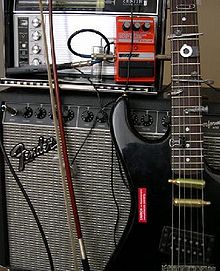Extended technique

Extended technique is a term that unorthodox or "wrong" techniques describes musical instruments to play or sing. This includes in particular alternative playing techniques such as multi-sounds ( multiphonics ), microtones, circular or continuous breathing, the creation of overtones or noises through special playing techniques such as flageolet fingering , changing an instrument ( prepared piano , prepared guitar ) and playing a wind instrument without a mouthpiece (or with the mouthpiece of a completely different instrument).
A corresponding expansion of the tonal language was strongly promoted by composers such as Henry Cowell , George Crumb , John Cage and Harry Partch . The "extended" techniques are particularly used in experimental music , noise and improvisation music , electroacoustic music , sometimes and also in sound art and in alternative music such as noise rock (for example by groups like Sonic Youth or, as a pioneer in this field, by Jimi Hendrix ) and electronic music like IDM .
Originally unorthodox techniques can, over time, establish themselves as recognized playing techniques, for example the use of a bottleneck or certain tremolo techniques when playing the guitar, or the use of a plunger damper when playing the trumpet.
See also
- Circuit bending (music produced with short circuits )
- Feedback
- Third bridge guitar
- Turntablism